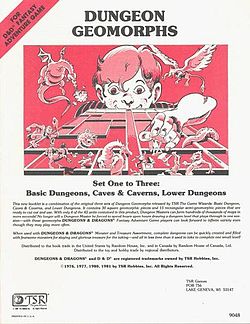- Dungeon Geomorphs
-
Dungeon Geomorphs 
Author(s) Gary Gygax Genre(s) Role-playing game Publisher TSR Publication date 1976 Dungeon Geomorphs is an accessory for the Dungeons & Dragons fantasy role-playing game.
Contents
Contents
The Dungeon Geomorphs were a DM's aid that consisted of dungeon map sections that can be cut apart and put together like puzzle pieces in various ways. Set One was for standard dungeon corridors and rooms, Set Two was for irregular dungeon corridors and rooms, and Set Three was for larger, stranger dungeons corridors and rooms.[1]:140 The Outdoor Geomorphs set was for a medieval walled city.[1]:146
Publication history
Dungeon Geomorphs, Set One: Basic Dungeon was designed by Gary Gygax and published by TSR in 1976.[1]:140 Dungeon Geomorphs, Set Two: Caves & Caverns was written by Gary and Ernie Gygax, and Dungeons Geomorphs, Set Three: Lower Dungeons was written by Gary Gygax, and sets two and three were published by TSR in 1977.[1]:140 Outdoor Geomorphs, Set One: Walled City was designed by Gary Gygax and also published by TSR in 1977.[1]:146 All of these initial sets consisted of 12 sheets of puzzle-piece map sections.[1]:140,146
Sets One, Two, and Three were compiled in 1980 as the Dungeon Geomorphs set, as 48 cardstock pages, with a cover by Bill Willingham.[1]:140 This was printed again in 1981.[1]:140 Each sheet in the booklet can be divided into two square and one rectangular map section; these are partially geomorphic, as not ever corridor will connect with every other one, but at least two always will.[2] The geomorphs are not given any scale, although the maps are covered with 1/4" gridsquares.[2]
Reception
Steve Jackson reviewed the 1980 compilation of Dungeons Geomorphs in The Space Gamer #41 in 1981.[2] Jackson felt that the geomorphs would be nice for any Dungeon Master who needs a complex dungeon level in a hurry.[2] Since they are well-keyed, he noted that a given layout could be quickly written down for later use, and they allow for a lot of possible combinations.[2] Jackson noted the lack of scale on the gridsquares and that one square could be taken as anywhere from 5 to 20 feet, although he felt that the designers probably intended them to be 10 feet.[2] He considered the choice of color a disappointment and the only real drawback, as the light-blue ink all the maps are printed in makes them hard to read.[2] Jackson concluded that the Dungeon Geomorphs are nice at the price, but not a "must".[2]
Kurt Butterfield also reviewed the Outdoor Geomorphs in the same issue of The Space Gamer.[3] According to Butterfield, this set of city plans helps a Dungeon Master to contstruct a fairly large walled city in a matter of minutes, saving an enormous amount of time and leaving the DM only to populate the city and add special details.[3] The notes that the walls, towers, and other structures are clearly mapped out in blue on durable, white graph paper with marked lines to allow them to be cut out; the square and rectangular pieces can then be fit together in almost any fashion the DM desires.[3] While Butterfield did not find much wrong with this set, he was annoyed by some unexplained shaded areas and the fact that the set wasn't as large as he would have liked; ultimately, he recommended the city geomorphs to almost any DM.[3]
References
- ^ a b c d e f g h Schick, Lawrence (1991). Heroic Worlds: A History and Guide to Role-Playing Games. Prometheus Books. ISBN 0-87975-653-5.
- ^ a b c d e f g h Jackson, Steve (July 1981). "Capsule Reviews". The Space Gamer (Steve Jackson Games) (41): 34.
- ^ a b c d Butterfield, Kurt (July 1981). "Capsule Reviews". The Space Gamer (Steve Jackson Games) (41): 34.
Categories:- Dungeons & Dragons books
Wikimedia Foundation. 2010.
